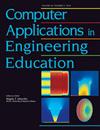求助PDF
{"title":"Solving boundary value problems in heterogeneous catalysis with orthogonal collocation and arc-length continuation","authors":"André Von-Held Soares, Housam Binous, Fernando Cunha Peixoto, Ahmed Bellagi","doi":"10.1002/cae.22701","DOIUrl":null,"url":null,"abstract":"<p>An important part of the education of chemical engineers involves the design and assessment of heterogeneous catalytic reactions. They pose fundamental phenomena and constitute invaluable industrial processes. Progressing in this field, especially in graduate-level courses, entails solving nonlinear differential equations systems, which can only be achieved by using efficient and reliable numerical techniques. In this work, we solve nonisothermal one-dimensional reaction-diffusion BVP considering convection in the boundary conditions, by applying orthogonal collocation and arc-length continuation. Particularly, we predict the effectiveness factor as a function of the Thiele modulus for the main three particle geometries: plane slab, cylinder, and sphere. For chemical engineering students, such problems are at the zenith of the discipline, and the results of such calculations can elucidate basic and advanced concepts of mass and heat transfer as well as chemical reaction engineering. Both Chebyshev and shifted Legendre polynomials were used to transform the boundary value problem into a set of algebraic nonlinear equations. In addition, we also compare our findings against the available analytic solutions whenever possible. Codes in Scilab, Matlab®, and Mathematica© were developed for the solution of such problems and are available in the Supporting Information. There are two possible approaches to compute effectiveness factors: (a) integration as per definition versus (b) differentiation and nonlinear system. It is demonstrable that software performance is dependent on the approach, and that the differentiation approach yields better results.</p>","PeriodicalId":50643,"journal":{"name":"Computer Applications in Engineering Education","volume":"32 2","pages":""},"PeriodicalIF":2.0000,"publicationDate":"2023-11-20","publicationTypes":"Journal Article","fieldsOfStudy":null,"isOpenAccess":false,"openAccessPdf":"","citationCount":"0","resultStr":null,"platform":"Semanticscholar","paperid":null,"PeriodicalName":"Computer Applications in Engineering Education","FirstCategoryId":"5","ListUrlMain":"https://onlinelibrary.wiley.com/doi/10.1002/cae.22701","RegionNum":3,"RegionCategory":"工程技术","ArticlePicture":[],"TitleCN":null,"AbstractTextCN":null,"PMCID":null,"EPubDate":"","PubModel":"","JCR":"Q3","JCRName":"COMPUTER SCIENCE, INTERDISCIPLINARY APPLICATIONS","Score":null,"Total":0}
引用次数: 0
引用
批量引用
Abstract
An important part of the education of chemical engineers involves the design and assessment of heterogeneous catalytic reactions. They pose fundamental phenomena and constitute invaluable industrial processes. Progressing in this field, especially in graduate-level courses, entails solving nonlinear differential equations systems, which can only be achieved by using efficient and reliable numerical techniques. In this work, we solve nonisothermal one-dimensional reaction-diffusion BVP considering convection in the boundary conditions, by applying orthogonal collocation and arc-length continuation. Particularly, we predict the effectiveness factor as a function of the Thiele modulus for the main three particle geometries: plane slab, cylinder, and sphere. For chemical engineering students, such problems are at the zenith of the discipline, and the results of such calculations can elucidate basic and advanced concepts of mass and heat transfer as well as chemical reaction engineering. Both Chebyshev and shifted Legendre polynomials were used to transform the boundary value problem into a set of algebraic nonlinear equations. In addition, we also compare our findings against the available analytic solutions whenever possible. Codes in Scilab, Matlab®, and Mathematica© were developed for the solution of such problems and are available in the Supporting Information. There are two possible approaches to compute effectiveness factors: (a) integration as per definition versus (b) differentiation and nonlinear system. It is demonstrable that software performance is dependent on the approach, and that the differentiation approach yields better results.

 求助内容:
求助内容: 应助结果提醒方式:
应助结果提醒方式:


